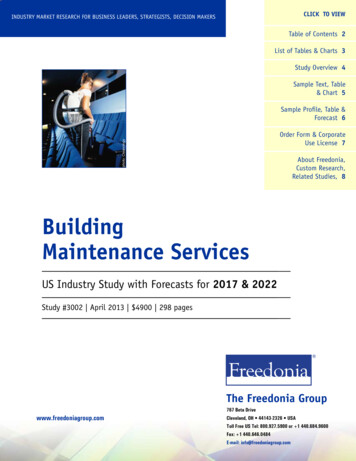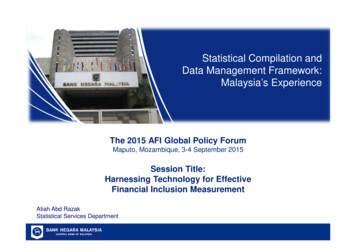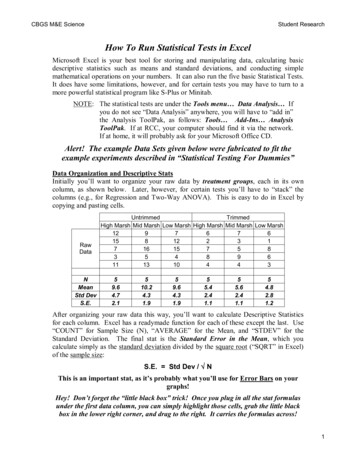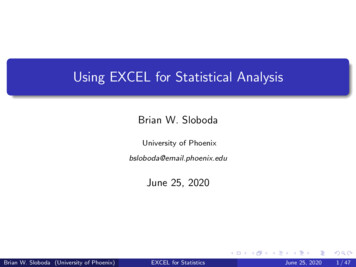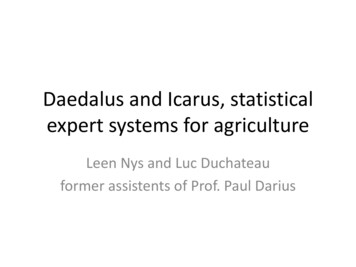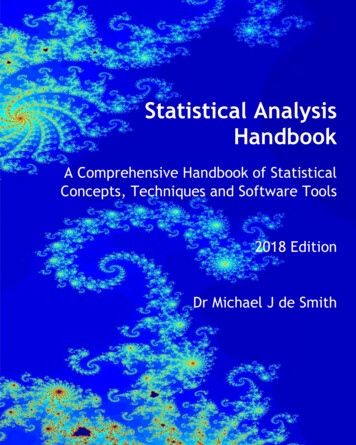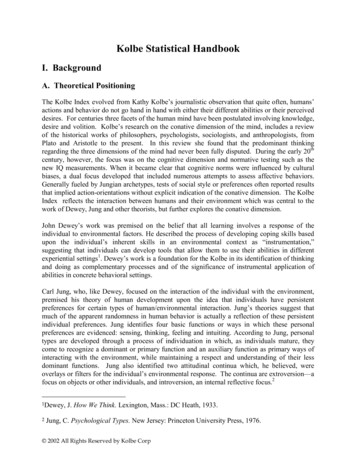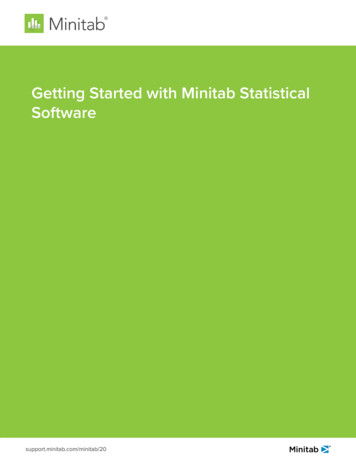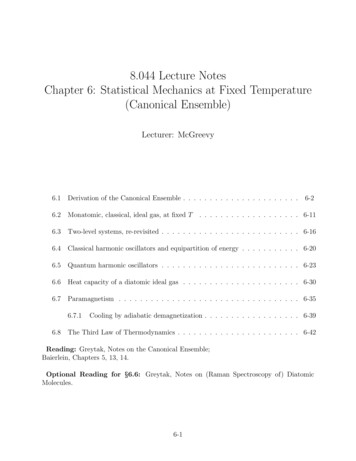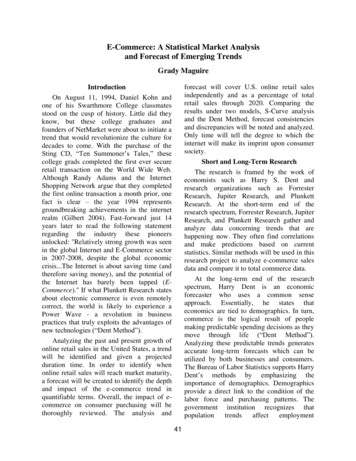
Transcription
E-Commerce: A Statistical Market Analysisand Forecast of Emerging TrendsGrady Maguireforecast will cover U.S. online retail salesindependently and as a percentage of totalretail sales through 2020. Comparing theresults under two models, S-Curve analysisand the Dent Method, forecast consistenciesand discrepancies will be noted and analyzed.Only time will tell the degree to which theinternet will make its imprint upon consumersociety.Short and Long-Term ResearchThe research is framed by the work ofeconomists such as Harry S. Dent andresearch organizations such as ForresterResearch, Jupiter Research, and PlunkettResearch. At the short-term end of theresearch spectrum, Forrester Research, JupiterResearch, and Plunkett Research gather andanalyze data concerning trends that arehappening now. They often find correlationsand make predictions based on currentstatistics. Similar methods will be used in thisresearch project to analyze e-commerce salesdata and compare it to total commerce data.At the long-term end of the researchspectrum, Harry Dent is an economicforecaster who uses a common senseapproach. Essentially, he states thateconomics are tied to demographics. In turn,commerce is the logical result of peoplemaking predictable spending decisions as theymove through life (“Dent Method”).Analyzing these predictable trends generatesaccurate long-term forecasts which can beutilized by both businesses and consumers.The Bureau of Labor Statistics supports HarryDent‟s methods by emphasizing theimportance of demographics. Demographicsprovide a direct link to the condition of thelabor force and purchasing patterns. Thegovernment institution recognizes thatpopulationtrendsaffectemploymentIntroductionOn August 11, 1994, Daniel Kohn andone of his Swarthmore College classmatesstood on the cusp of history. Little did theyknow, but these college graduates andfounders of NetMarket were about to initiate atrend that would revolutionize the culture fordecades to come. With the purchase of theSting CD, “Ten Summoner‟s Tales,” thesecollege grads completed the first ever secureretail transaction on the World Wide Web.Although Randy Adams and the InternetShopping Network argue that they completedthe first online transaction a month prior, onefact is clear – the year 1994 representsgroundbreaking achievements in the internetrealm (Gilbert 2004). Fast-forward just 14years later to read the following statementregarding the industry these pioneersunlocked: "Relatively strong growth was seenin the global Internet and E-Commerce sectorin 2007-2008, despite the global economiccrisis.The Internet is about saving time (andtherefore saving money), and the potential ofthe Internet has barely been tapped (ECommerce)." If what Plunkett Research statesabout electronic commerce is even remotelycorrect, the world is likely to experience aPower Wave - a revolution in businesspractices that truly exploits the advantages ofnew technologies (“Dent Method”).Analyzing the past and present growth ofonline retail sales in the United States, a trendwill be identified and given a projectedduration time. In order to identify whenonline retail sales will reach market maturity,a forecast will be created to identify the depthand impact of the e-commerce trend inquantifiable terms. Overall, the impact of ecommerce on consumer purchasing will bethoroughly reviewed. The analysis and41
opportunities by influencing the demand forgoods and services. Population changesproduce related changes in the demographiccomposition and size of the labor force. TheBureau of Labor Statistics also states that“Population is the single most importantfactor in determining the size andcompositionofthelaborforce ”(“Tomorrow‟s Jobs”). Since such a highdegree of importance is placed on thecomposition and size of American society,much attention will be placed on analyzingdemographic trends and their relation toconsumption.Usingaforementionedtechniques, the research will consist offinding and analyzing the e-commerce trendas it emerges. The better data can be used inaccordance to accepted methodologies such asthe Dent Method, the more accurate anduseful the predictions will be.Research MethodsIn order to accurately analyze and forecastthe online shopping trend, adherence toindustry-approved methods is tantamount.The primary methodologies used will be theDent Method (mentioned above), SPSSanalysis, and S-Curve Economics. Followingindustry standards for social science researchwill provide a solid foundation for thegeneration of reliable forecasts.First of all, Statistical Package for SocialSciences (SPSS) is a widely used analysis toolfor the social sciences. Recently rebranded asPredictive Analytics SoftWare (PASW) in2009, the statistical analysis tool can beimplemented to interpret data in a number ofways. The software can be used to finddifferences, relationships, or descriptions ofdata. However, no analysis is meaningfulunless the data is reliable and valid. Data isreliable if it can “consistently measure thetopic under study at different times and acrossdifferent populations” (Hinton 356). On theother hand, validity refers to the strength ofthe conclusion. Simply put, are they right?Keeping both reliability and validity in mind,SPSS becomes a powerful tool. SPSS createsa mathematical way in which to make factbased predictions using current data.Furthermore, finding correlations in the datawill help generate predictive models foranalysis and conclusion. While SPSSfacilitates the detailed analysis of e-commercedata, it is the methodology of S-Curveeconomics which enables trends to beforecasted.S-Curve economics illustrates theintroduction, growth, and maturation ofinnovations as well as the technologicalcycles that most industries experience.Essentially, an S-Curve can be broken downinto four phases: innovation, growth,maturity, and decline. Innovation refers to theintroduction of a new product or technologyto the market place. The majority of productsand technologies never make it past the firstphase due to the high costs and low revenuesassociated with new ideas. Specifically, theinnovation phase represents the period of timewhen 0%-10% of the market adopts the newtechnology or product. As a product movesthrough the innovation phase, marketadoption grows very slowly if it is adopted atall. However, once a concept, such as ecommerce, reaches 10% market penetration, itis said to be a concept whose „time has come.‟Entering the growth phase, which represents10%-90% market penetration, the conceptstarts to grow in an exponential fashion.Unlike the slow growth during innovation,once about one out of every ten people readilyuses the technology, it begins to grow likewildfire. To put it into perspective, it takesroughly the same period of time to grow from10%-90% as it did to grow from 0-10%market penetration. Virtually nothing can stopits rapid growth once it enters into the growthphase. As adoption nears nine out of every tenpeople, growth slows as it enters maturity.Although almost no technology is universallyadopted and reaches 100% marketpenetration, maturity refers to slow growth42
that occurs between 90% and 100%. Once amarket matures, growth often tapers off anddeclines. The decline phase only occurs whena new technology or product is created whichmakes the old obsolete. Once the new beginsto be readily adopted by the masses, the oldstarts its decline. The S-Curve is essential tounderstanding how markets move. Combinedwith the Dent Method, it further improves theaccuracy of forecasts related to e-commerce.Initial ProjectionsBased on current data, it is projected thate-commerce will experience the growth phaseof its S-Curve over the next decade. I expectthe rapid growth to result in the maturation(roughly 90% penetration of the potentialmarket) of online shopping by 2020. Despitethe current economic downturn, e-commercecontinues to grow while other industries movebackward (“E-Commerce”). Since onlineshopping is based on saving time and moneyfor the consumer, as well as the businessowner, hard economic times will only deepenthe e-commerce trend. While sales may notincrease as rapidly as in strong financialconditions, individuals will look to spendtheir limited finances in as efficient a fashionas possible. The internet, coupled with theability to do comparison shopping, research,analyze customer reviews, and order from asingle location, provides the demandedshopping efficiency.S-Curve economics presents a case for therapid growth of online shopping. Due to thenature of market development, exponentialgrowth occurs once a new technology reachesroughly 10% market penetration andcontinues until it reaches roughly 90% marketpenetration. Data compiled by ForresterResearch shows that e-commerce has enteredits growth phase in the United States. Theirdefinition of e-commerce retail sales includesall online sales except auto, travel, andprescription drug sales. Since the expectedmarket cap of US online sales is 50% of totalU.S. sales, the growth phase begins onceonline sales equal 5% of all sales. In 2007, thefeat was achieved according to ForresterResearch when online retail sales reached 5%of all retail sales in America (“U.S. ECommerce”). Historical evidence stronglysuggests that a period of exponential growthwill follow, accelerated by the speed of theinformation age. As stated earlier, newproducts and technology generally take thesame time to complete the introduction phaseas they do to complete the growth phase. Ecommerce appears to have its humblebeginnings during the latter months of 1994.Since it took 13 years (from 1994-2007) for ecommerce to reach 10% market penetration, itis expected to take approximately 13 yearsfrom 2007 for US online sales to reach 45%of total US sales, which is 90% penetration ofthe projected market. According to my initialprojections, e-commerce would complete itsgrowth phase during the year 2020. Theresults may be historically significant as theAmerican culture is transformed by internetshopping.Cultural ImpactThe fact that American society is in themidst of a culture-changing trend makes it asignificant area of investigation forAmericans in general, for research, and forthe business field. On the individual level, ecommerce tends to save Americans both timeand money. Online shopping allowsconsumers to compare costs and read productreviews from the comfort of one‟s own home.This saves time that would otherwise be spentin traffic or waiting in line. The nature of ecommerce forces businesses to respect theconsumer. The internet makes it easier thanever to compare and contrast products, doresearch, and read reviews. Businesses mustoffer customers competitive pricing and asatisfying online experience or risk losing thesale. With the click of a button, customers canleave one virtual store and enter another.According to a Forrester Research report,retailers must make their websites more43
conducive to browsing. They can elicit favorwith shoppers by focusing additional energyon accurate product information, improvedimagery, flexibility in payments and returns,and by reducing the hurdles of shipping costs(Rosencrance 2008).Essentially, ecommerce empowers the consumer. Theconcept of consumer empowerment isdemonstrated by the fact that people‟s actionson the internet dictate the response ofbusinesses. The supply of specificinformation, products, and services is tailoredto the individual based on past purchases orsearch results. The level of consumerempowerment created online cannot beduplicated in the traditional store.On the research level, e-commerce isimportant because it is altering the face of theconsumer.Asconvergenceofthetelecommunication industry and internetoccurs, individuals change the way they buyproducts and services, communicate, bank,pay bills, and research information.According to one of the world‟s leadingauthorities on technology and trends shapingthe world of wireless mobility, Mr. AndrewM. Seybold, this connection allows for greateraccess to voice, audio, data, and videoservices than ever before (Seybold 11). Newresearch is now necessary to understand howthe new consumer makes decisions. Asinformation is constantly changing, a rapidresponse from researchers is required to stayup-to-date. Online shopping is creating majorchanges in not only the way consumers think,but the way in which businesses market totheir customers. The growth of e-commerceand converging technologies recreate the needfor trust. Analyzing the need for trust iscentral to market research. Piotr Cofta, ChiefResearcher in British Telecom‟s MobilityResearch Group, shows that without a trust inbusinesses or the medium through which thetransaction takes place (the internet), nocommercial transaction will occur no matterhow convenient or developed the technologyis (Cofta 1).Despite the recent scare of entering creditcard and personal information online, securitymeasures and higher encryption standardsallow consumers to trust the safety of onlineshopping. In the 21st century, it has becomemore a risk to hand one‟s credit card to aclerk in a store than to enter the informationon a mainstream website. Although risks doexist on lesser known websites with lowerlevels of data encryption, the majority ofcompetitive internet companies offer highlevels of security for customers. More andmore online firms offer all-encompassingreturn policies. Such policies guarantee thatthe customers receive the exact product theyare looking for in excellent condition. If theyare not satisfied, they can send it back to thecompany for replacement or refund. As returnpolicies are improved, customers will be moreconfident in making purchases over theinternet. E-commerce will continue to flourishand grow if trust continues to grow in theminds of consumers. On both sides of theequation, e-commerce is laying thegroundwork for major changes in society –changes which pave the way for futureresearch.On the retail level, internet shopping isextremely significant to the business field.Currently, many businesses are changing theirfocus from traditional retailing to drivingonline sales. According to Ken Allard, a chiefexecutive strategist, a wide range oforganizations are making large investments ininternet commerce. He understands the newinvestment cycle to be the result of four maintrends, consisting of internet commercebecoming a reliable engine for growth, newweb technologies enabling additionalcapabilities, both consumers and businessesdemanding new features and services, andmarketing budgets shifting to the internet(Allard). As current trends propel onlineshopping to not simply become the way of the44
future but the way of the present, companiesmust quickly adapt their business practices tomeet the growing demand. Similar toresearchers, businesses must learn tounderstand the changing face of theconsumer. They must learn to supplycustomers with what they want and how theywant it, while competing with more and morecompetitors online. If actions are not taken toutilize the marketplace of the future, onlinemarket share is lost daily. Companies simplywill not survive if they do not have a viableinternet option for customers to access.Preliminary FindingsI initially projected that e-commerce retailsales will become a mature market by 2020based on Forrester Research‟s e-commercesales data. According to Forrester‟s measureof online retail sales (which excludes auto,travel, and prescription drug sales), ecommerce entered its growth phase (10%market penetration) in 2007. However, for thepurpose of this report, I will be utilizing theU.S. Census Bureau‟s measure of online retailsales. Their measure includes all online retailtransactions except online travel services,financial brokers and dealers, and ticket salesagencies. Since they record e-commerce datadifferently than Forrester Research, onlineretail sales were only 3.17% of total retailsales (6.34% market penetration) in 2007(“Measuring the Electronic Economy”). Thus,e-commerce as recorded by the U.S. CensusBureau has not yet entered its growth phase.Using this scale means that U.S. online retailsales are not expected to reach 90% marketpenetration until after 2020.Since I have not yet had access to SPSSsoftware, my forecast under the S-Curvemodel is based on an exponential regression(LOGEST function) in Microsoft Excel.Although a logistic regression would be moreaccurate in forecasting a complete S-Curve,Excel does not currently have such a function.Until I have access to a logistic analysis tool,the exponential regression will do a good jobof forecasting the exponential growth portionof the S-Curve (which is the portion I amanalyzing). Using both online and offlineretail sales data from 1999-2008, I forecastedthe growth rate of retail e-commerce sales, thevolume of retail e-commerce sales, the retaile-commerce growth rate as a percentage oftotal retail sales, and the final e-commercepercentage of total retail sales for each yearfrom 2009-2020. According to my forecasts,online retail sales will not enter the growthphase until 2011 when they represent 5.8% oftotal retail sales (11.6% market penetration) inthe US. At this level, online retail sales willtotal over 257 billion in 2011. My short-termforecasts line up closely to that of Forresterresearch, which predicts that e-commercesales will reach 334.7 billion in 2012(Rosencrance 2008). My forecasts place the2012 online retail sales forecast at 318.57billion. The variation may exist due todifferences in the definition of an online retailsale. Different forecasting methods might alsobe a reason for the discrepancy. Nonetheless,my short-term estimates are stronglycorrelated with a well-established forecastingcompany.In the long-run, I predict that online retailsales will surpass 1 trillion by 2018according to the model. Online sales areexpected to exceed 1.6 trillion in ecommerce sales in 2020. At this point in time,e-commerce should capture approximately27% of total retail sales (54% marketpenetration) in the United States. If thiscomes to pass, the e-commerce trend willcontinue for at least another decade until itcaptures 45% of total retail sales (90% marketpenetration) and becomes a mature market.Besides considering the factors of S-CurveEconomics, the Dent Method should beconsidered in the analysis as well.The Dent Method allows economists tologically forecast future consumption in theU.S. The forecast is ultimately determined bythe size and composition of the population.45
Personal consumption represents roughly70% of the Gross Domestic Product inAmerica. At an average age of 47.5,consumers reach their predictable peak inspending (“Dent Method”). The consumerinfluences the overall economy greatly in theU.S. It is important to analyze the size ofthose groups in their peak spending yearsduring the e-commerce trend from 20002020. This will provide better a betterunderstanding of the growth rates estimated inthe regression analysis.Based on the most recent U.S. Census of2000, 60.1 million people were between theages of 40 and 54 years of age in 2000 (“QTP1. Age Groups and Sex: 2000”). This agebracket represents groups in their peakspending years according to the Dent Method.From 2000 to 2010, the number of peoplebetween 40 and 54 years old grew over 9.2%to 65.7 million (the growth level assumes thesame number of individuals who were 30-44years old in 2000 are now 40-54 years old in2010). However, from 2010 to 2020, thenumber of people between 40 and 54 yearsold is expected to fall roughly 10.4% to 58.9million. The contraction in the populationrepresents a larger generation (the BabyBoomers) preceding a smaller generation(Generation X). This may impact the ecommerce trend in a number of ways. Sincethere is an expected reduction of those whowill be in the peak spending years from 2010to 2020, I expect personal consumption togrow slowly or even fall during the decade.Due to the anticipated slow-down inspending,
based predictions using current data. Furthermore, finding correlations in the data will help generate predictive models for analysis and conclusion. While SPSS facilitates the detailed analysis of e-commerce data, it is the methodology of

